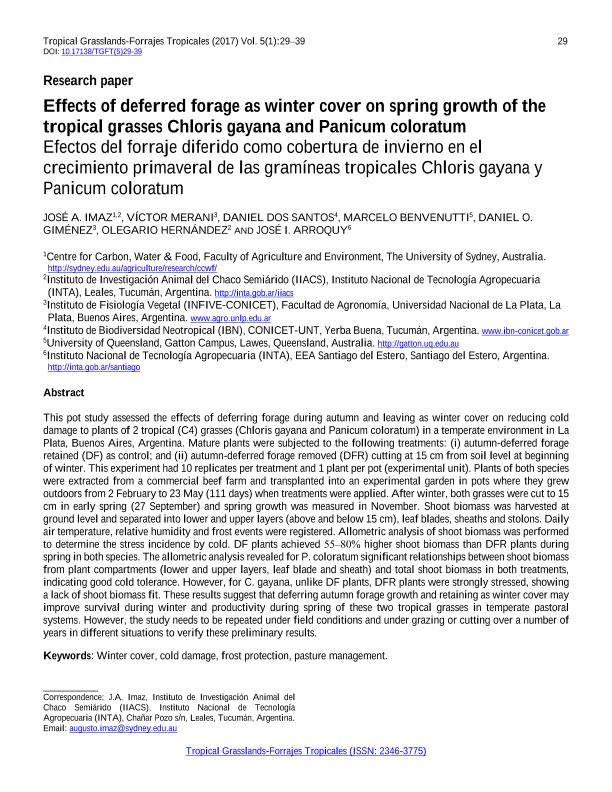Artículo
Effects of deferred forage as winter cover on spring growth of the tropical grasses Chloris gayana and Panicum coloratum
Título:
Efectos del forraje diferido como cobertura de invierno en el crecimiento primaveral de las gramíneas tropicales Chloris gayana y Panicum coloratum
Imaz, José Augusto; Merani, Víctor; Dos Santos, Daniel Andrés ; Benvenutti, Marcelo; Gimenez, Daniel Oscar; Hernandez, Olegario; Arroquy, Jose Ignacio
; Benvenutti, Marcelo; Gimenez, Daniel Oscar; Hernandez, Olegario; Arroquy, Jose Ignacio
 ; Benvenutti, Marcelo; Gimenez, Daniel Oscar; Hernandez, Olegario; Arroquy, Jose Ignacio
; Benvenutti, Marcelo; Gimenez, Daniel Oscar; Hernandez, Olegario; Arroquy, Jose Ignacio
Fecha de publicación:
01/2017
Editorial:
Centro Internacional de Agricultura Tropical
Revista:
Tropical Grasslands-Forrajes Tropicales
ISSN:
2346-3775
e-ISSN:
2346-3775
Idioma:
Inglés
Tipo de recurso:
Artículo publicado
Clasificación temática:
Resumen
This pot study assessed the effects of deferring forage during autumn and leaving as winter cover on reducing cold damage to plants of 2 tropical (C4) grasses (Chloris gayana and Panicum coloratum) in a temperate environment in La Plata, Buenos Aires, Argentina. Mature plants were subjected to the following treatments: (i) autumn-deferred forage retained (DF) as control; and (ii) autumn-deferred forage removed (DFR) cutting at 15 cm from soil level at beginning of winter. This experiment had 10 replicates per treatment and 1 plant per pot (experimental unit). Plants of both species were extracted from a commercial beef farm and transplanted into an experimental garden in pots where they grew outdoors from 2 February to 23 May (111 days) when treatments were applied. After winter, both grasses were cut to 15 cm in early spring (27 September) and spring growth was measured in November. Shoot biomass was harvested at ground level and separated into lower and upper layers (above and below 15 cm), leaf blades, sheaths and stolons. Daily air temperature, relative humidity and frost events were registered. Allometric analysis of shoot biomass was performed to determine the stress incidence by cold. DF plants achieved 55-80% higher shoot biomass than DFR plants during spring in both species. The allometric analysis revealed for P. coloratum significant relationships between shoot biomass from plant compartments (lower and upper layers, leaf blade and sheath) and total shoot biomass in both treatments, indicating good cold tolerance. However, for C. gayana, unlike DF plants, DFR plants were strongly stressed, showing a lack of shoot biomass fit. These results suggest that deferring autumn forage growth and retaining as winter cover may improve survival during winter and productivity during spring of these two tropical grasses in temperate pastoral systems. However, the study needs to be repeated under field conditions and under grazing or cutting over a number of years in different situations to verify these preliminary results.
Palabras clave:
Cold Damage
,
Frost Protection
,
Pasture Management
,
Winter Cover
Archivos asociados
Licencia
Identificadores
Colecciones
Articulos(IBN)
Articulos de INSTITUTO DE BIODIVERSIDAD NEOTROPICAL
Articulos de INSTITUTO DE BIODIVERSIDAD NEOTROPICAL
Citación
Imaz, José Augusto; Merani, Víctor; Dos Santos, Daniel Andrés; Benvenutti, Marcelo; Gimenez, Daniel Oscar; et al.; Effects of deferred forage as winter cover on spring growth of the tropical grasses Chloris gayana and Panicum coloratum; Centro Internacional de Agricultura Tropical; Tropical Grasslands-Forrajes Tropicales; 5; 1; 1-2017; 29-39
Compartir
Altmétricas



